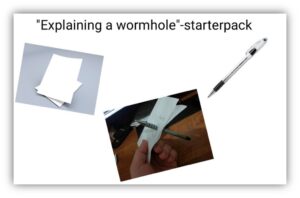Produced in 2014, Interstellar is an all-star classic space movie, a favorite for many space lovers! Director Christopher Nolan’s Interstellar movie is a science-fiction film that occurs in the future where a severe drought has resulted in dust-storms, destroyed most of Earth’s crops and caused humans to die of disease and famine. Cooper (played by Matthew McConaughey) and a team of NASA scientists are tasked with saving humanity by going through a wormhole that bends space and time, in hopes to find a habitable planet. This inter-galactic drama is full of suspense and mind-blowing scientific concepts. But how much of Interstellar depictions about space are true? Let’s play a little game of true or false to find out!
True or False?
Time moves more slowly in a black hole than it does for people on Earth.
ANSWER: TRUE
A blackhole is essentially a place in space with an “infinite gravitational pull” that not even light can escape. The slowing of time is humungous near a black hole’s horizon, where the pull of gravity is humungous. Likewise, because the flow of time ceases at the horizon, the pull of gravity is infinite. Time still flows inside the horizon of a black hole; however, the flow of time is in a spatial direction – toward the singularity at the hole’s center (Thorne, 1986). If you were to reach down near a black hole’s horizon and stay there for a few days before returning home to Earth, you would find that millions of years have elapsed on Earth; while you only aged a few days, your family and friends are long gone (Thorne, 1986).

True or False?
If a wormhole were to appear in space, it would provide a short cut from one side of the universe to another.
ANSWER: TRUE (for the most part)
The theory of general relativity supports the possibility of wormholes and their ability to create space-time shortcuts to other universes (Tillman, 2022). Einstein’s theory of general relativity mathematically predicts the existence of wormholes, where there is a black hole at the mouth of each wormhole (Tillman, 2022). However, a wormhole is not created solely by when a dying star collapses to form a naturally occurring black hole. According to Princeton cosmologist J. Richard Gott, “It takes a massive object to generate a gravity field sufficient to fold space-time in half, and the one in the movie would have to be the equivalent of 100 million of our suns” (Kluger, 2014). In addition, ‘negative energy’ or an energetic state that is less than zero, is required to create the portal of a wormhole and keep it open (Kluger, 2014).

True or False?
You could survive the leap into a black hole.
ANSWER: FALSE
What happens when you enter a black hole? One word: Spaghettification. A black hole would stretch your body into a thin ribbon (ESO Supernova, 2022). Ultimately, you will get shredded by extreme gravity. In reality, Matthew McConaughey should have been spaghettified. Not in the yummy, savory way, though.

True or False?
Planets surrounding a black hole (like in Interstellar’s “Gargantua”) could be inhabitable.
ANSWER: FALSE
Planets that surround a black hole are highly unlikely to be able to harvest life because they are so close to the black hole, making them unstable (Phillips, 2020). An important factor in determining whether a planet is inhabitable or not is how its planetary system associated with it is like. For that to happen, a Sun-like star needs to be there. However, a planet near a black hole most likely had its “Sun” sucked into the black hole, thus the planets would deem uninhabitable.
References:
ESO Supernova. (2022). What happens if you fall into a black hole? ESO Supernova Exhibition -. Retrieved February 17, 2022, from https://supernova.eso.org/exhibition/1205/#:~:text=The%20gravitational%20attraction%20of%20a,even%20light%20can%20escape%20it.&text=Spaghettification%3A%20A%20black%20hole%20would,stronger%20than%20on%20their%20head
Kluger, J. (2014, November 7). What ‘interstellar’ got right and wrong about science. Time. Retrieved February 17, 2022, from https://time.com/3572988/interstellar-science-fact-check/
Phillips, P. (2020, May 15). Times Interstellar Got Science All Wrong. Looper.com. Retrieved February 17, 2022, from https://www.looper.com/210013/times-interstellar-got-science-all-wrong/
Thorne, K. (1986). Black Holes. Black Holes The Most Luminous Objects in the Universe, But No Light! Retrieved February 17, 2022, from https://vdocuments.mx/black-holes-thorne.html
Tillman, N. T., & Harvey, A. (2022, January 13). What is wormhole theory? Space.com. Retrieved February 17, 2022, from https://www.space.com/20881-wormholes.html

